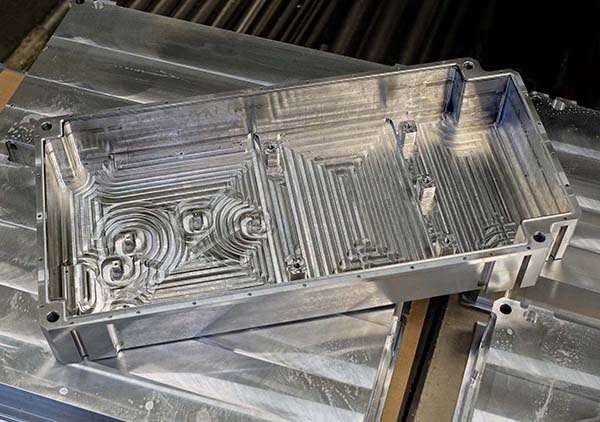David Watt, owner of subcontractor DW Engineering, has trebled the size of his business since the beginning of the decade, with most of that growth taking place last year, when turnover doubled. He puts this success partly down to winning contracts for machining batch sizes up to 10 times larger than previously, which he largely fulfils using four Hurco vertical machining centres. Orders are now frequently received for thousands-off rather than hundreds.

New work in the electronics and gas detection sectors has been secured, as well as in the resurgent oil and gas industry, while 80% of throughput is repeat business, some of which has been retained practically since the company was formed.
A further contributor to increased turnover and indeed profitability is Adaptipath high-speed machining software, which includes novel routines for rest-material removal in the latest version of Hurco’s WinMAX conversational control. Program cycles are significantly faster, especially when pocket milling.
Established in 2005 in Blantyre, near Hamilton, the subcontractor started using Hurco equipment from the outset with the purchase of a machining centre of nominally half-metre-cube capacity, and two CNC knee-type mills.

Together with a Hurco VM10 machining centre acquired five years later, these four machines were subsequently traded in for three of Hurco’s latest VM10i CNC vertical machining centres. One arrived in 2018 and was joined by two more this year. Additionally, there remains on the shop floor a smaller Hurco VM1 with 4th axis purchased in 2009, as well as a bar-fed Hurco TM8 CNC lathe that was installed six years later.
The Hurco VM10i offers travels of 660 x 406 x 508 mm in the X, Y and Z axes respectively, with a spindle nose to table distance of 102 mm. The 762 x 406 mm table is designed to span the entire Y axis, providing sufficient flexibility to produce a high mix of parts. Table loads of up to 340 kg can be accommodated. The machine is served by a 10,000 rpm spindle offering a power output of 11 kW and torque of 73.6 Nm at 1450 rpm. A rapid traverse rate of 24 m/min is offered in all three axes. Also provided as standard is an electric, side-mounted, 20-tool ATC. The swing-arm design means the ATC stays out the way, maximising the size of the work cube.
Comparing the performance of the nine-year-old VM1 with that of his three modern, slightly larger capacity Hurco VM10i vertical machining centres, Watt refers to an aluminium housing for an electronics industry customer that he has produced in two operations on both types of machine.

On the earlier model running a previous release of WinMAX programming software that included Ultipocket milling routines, the total cycle time was 165 minutes. However, that was before Hurco introduced Ultimotion software to control axis movements on its machines, without relying on hardware-based motion control. This addition has helped to reduce the cycle time for producing the electronics housing to 120 minutes, a saving of more than 27%.
Contributing especially to this increase in efficiency is the Adaptipath pocket-milling software with its new rest machining routines. The conversational pocketing feature is a module within Ultipocket in WinMax 10, mirroring that used in high-end CAD systems. This feature smooths the motion of the tool path and keeps chip load between a user-defined maximum and minimum, improving surface finish and extending tool life.
In addition to the two standard pocketing cycles involving inward and outward spiralling of the cutter, Adaptipath includes two extra rest machining routines, zig-zag and one-way, both of which involve alternate periods of climb milling. The amount of material encountered by the cutter is controlled, often allowing a full depth of cut rather than peck level milling, for higher metal removal rates that Watt says can be up to double.
With rest machining, a larger diameter tool than usual is used after roughing to remove most of the remaining unwanted material efficiently, followed by a finishing pass that automatically swaps the tool for a smaller diameter cutter to reach areas of the feature which the larger rest milling tool is unable to access. Watt considers this to offer a six to eight fold speed increase compared with previous machining methodology.
Looking back at his company’s progress over the past 14 years, he says: “The variety of materials we are asked to process is vast, ranging from stainless and mild steel, through titanium, copper, bronze, brass and aluminium, to PTFE, PEEK, acetal and nylon. Accuracies of ±0.1 mm are routinely achieved, but some parts have drawing tolerances down to ±10 µm.

“We have never needed a CAM system to prepare programs for the Hurco machining centres, as the on-board conversational software is so powerful at creating the cutter paths – and there is no need for post processing,” explains Watt. “If any particularly complex geometry is included in a CAD model supplied by a customer, we use AutoCAD or SolidWorks to produce a DXF file that WinMAX imports directly.
“The Hurco machines, which continue to evolve and improve, have supported our diverse work and underpinned our success,” he concludes. “They are key to our ability to offer top-quality work, quick turnaround times and competitive prices.”
For further information www.hurco.co.uk















